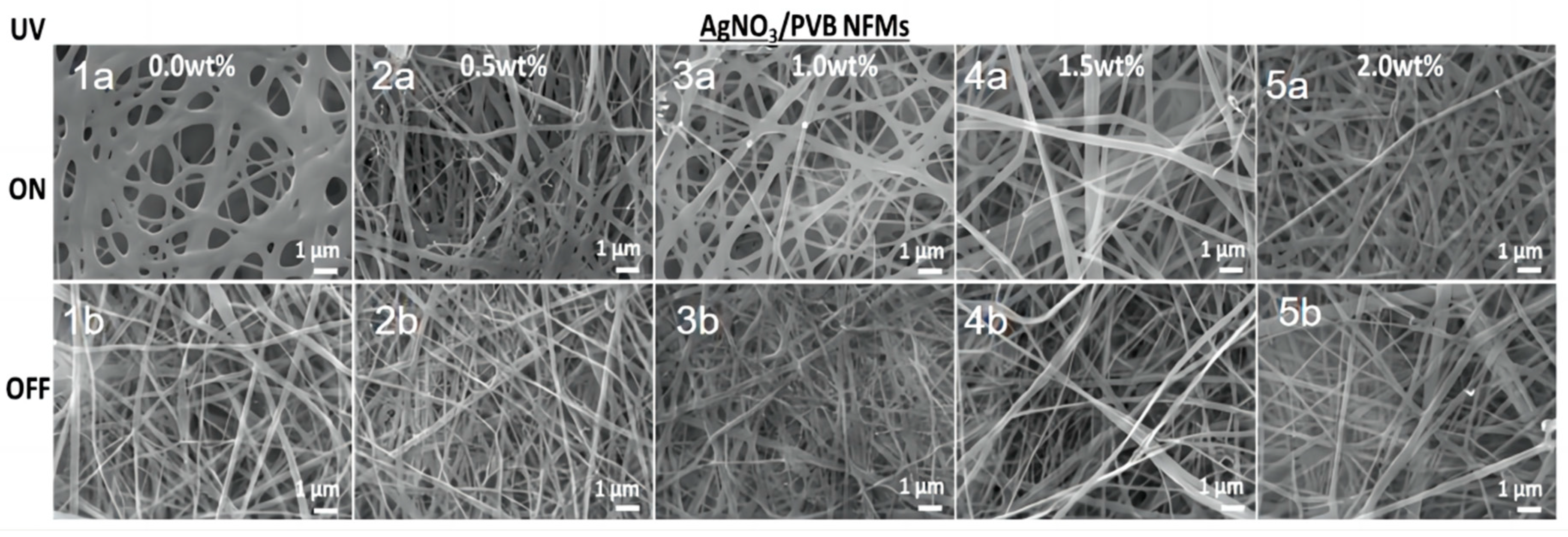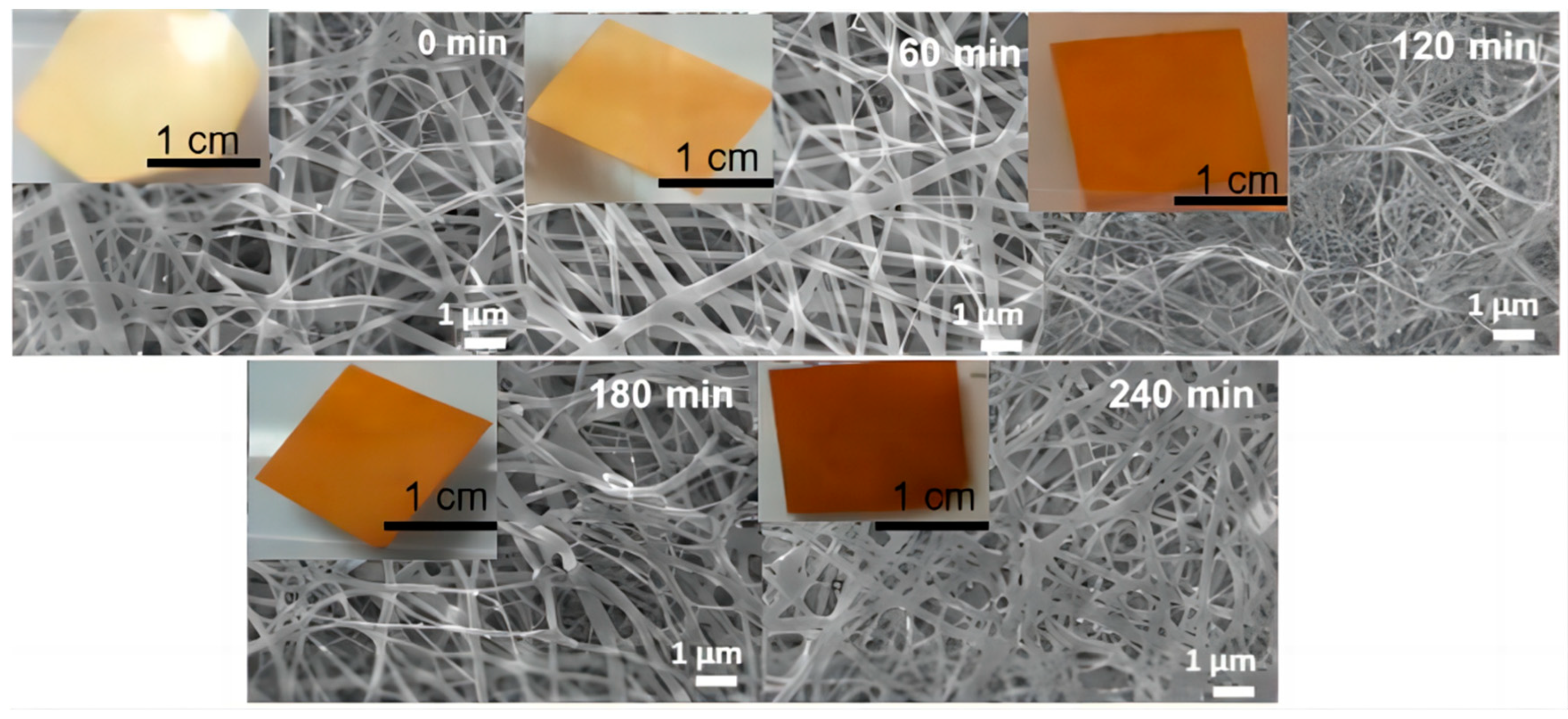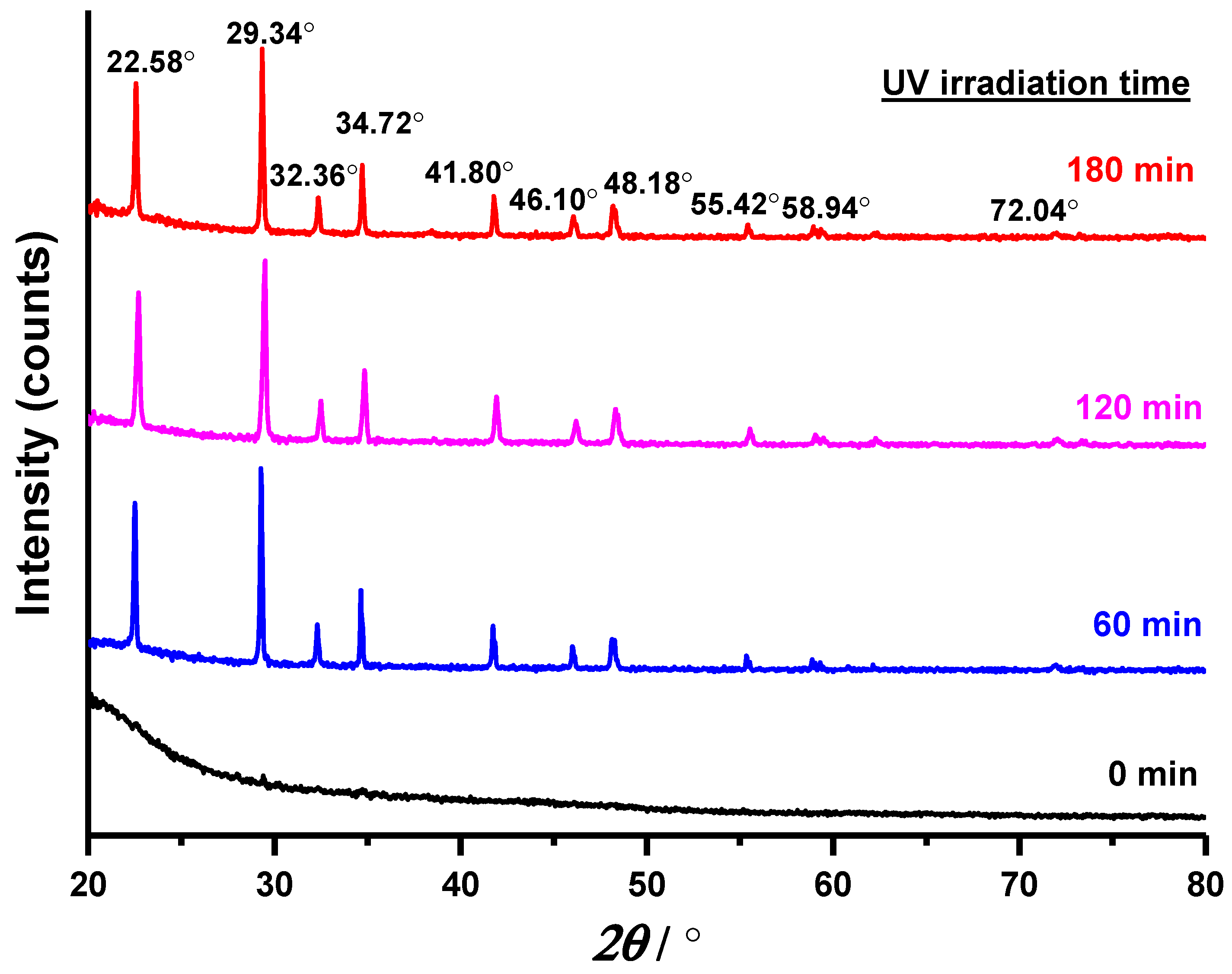Multi-Functional Electrospun AgNO3/PVB and Its Ag NP/PVB Nanofiber Membrane
Abstract
:1. Introduction
2. Results and Discussion
2.1. Morphological Analysis
2.2. XRD Analysis
2.3. Anti-UV Performance Test and Analysis
2.4. Electromagnetic Radiation Protection Performance Test and Analysis
3. Experiment
3.1. Materials
3.2. Preparation
3.3. Characterization
4. Conclusions
Author Contributions
Funding
Institutional Review Board Statement
Informed Consent Statement
Data Availability Statement
Conflicts of Interest
Sample Availability
References
- Satpathy, R.; Pamuru, V. Manufacturing of crystalline silicon solar PV modules. In Solar PV Power; Elsevier: Amsterdam, The Netherlands, 2021; pp. 135–241. [Google Scholar]
- Ipakchi, H.; Masoud Rezadoust, A.; Esfandeh, M.; Mirshekar, H. Modeling and optimization of electrospinning conditions of PVB nanofiber by RSM and PSO-LSSVM models for improved interlaminar fracture toughness of laminated composites. J. Compos. Mater. 2020, 54, 363–378. [Google Scholar] [CrossRef]
- Yi, L.; Wang, Y.; Fang, Y.; Zhang, M.; Yao, J.; Wang, L.; Marek, J. Development of core-sheath structured smart nanofibers by coaxial electrospinning for thermo-regulated textiles. RSC Adv. 2019, 9, 21844–21851. [Google Scholar] [CrossRef] [PubMed]
- Havlíček, K.; Svobodová, L.; Bakalova, T.; Lederer, T. Influence of electrospinning methods on characteristics of polyvinyl butyral and polyurethane nanofibres essential for biological applications. Mater. Des. 2020, 194, 108898. [Google Scholar] [CrossRef]
- Song, X.; Zhang, K.; Song, Y.; Duan, Z.; Liu, Q.; Liu, Y. Morphology, microstructure and mechanical properties of electrospun alumina nanofibers prepared using different polymer templates: A comparative study. J. Alloys Compd. 2020, 829, 154502. [Google Scholar] [CrossRef]
- Krysiak, Z.J.; Kaniuk, Ł.; Metwally, S.; Szewczyk, P.K.; Sroczyk, E.A.; Peer, P.; Lisiecka-Graca, P.; Bailey, R.J.; Bilotti, E.; Stachewicz, U. Nano-and microfiber PVB patches as natural oil carriers for atopic skin treatment. ACS Appl. Bio Mater. 2020, 3, 7666–7676. [Google Scholar] [CrossRef]
- Krysiak, Z.J.; Szewczyk, P.K.; Berniak, K.; Sroczyk, E.A.; Boratyn, E.; Stachewicz, U. Stretchable skin hydrating PVB patches with controlled pores’ size and shape for deliberate evening primrose oil spreading, transport and release. Biomater. Adv. 2022, 136, 212786. [Google Scholar] [CrossRef] [PubMed]
- Song, X.; Song, Y.; Wang, J.; Liu, Q.; Duan, Z. Insights into the pore-forming effect of polyvinyl butyral (PVB) as the polymer template to synthesize mesoporous alumina nanofibers via electrospinning. Ceram. Int. 2020, 46, 9952–9956. [Google Scholar] [CrossRef]
- Fan, X.; Dai, J.; Wei, L.; Feng, Y.; Sun, R.; Dong, J.; Wang, Q. Fabrication and thermal insulation properties of ceramic felts constructed by electrospunγ-Y2Si2O7 fibers. Ceram. Int. 2022, 48, 29913–29918. [Google Scholar] [CrossRef]
- Zakaria, M.; Nakane, K. Fabrication of polypropylene nanofibers from polypropylene/polyvinyl butyral blend films using laser-assisted melt-electrospinning. Polym. Eng. Sci. 2020, 60, 362–370. [Google Scholar] [CrossRef]
- Kimura, S.; Wakatsuki, H.; Nakamura, K.; Kobayashi, N. Compensative electrochromic device utilizing electro-deposited plasmonic silver nanoparticles and manganese oxide to achieve retention of chromatic color. Electrochemistry 2022, 90, 047002. [Google Scholar] [CrossRef]
- Molcan, M.; Safarik, I.; Pospiskova, K.; Paulovicova, K.; Timko, M.; Kopcansky, P.; Torma, N. Magnetically Modified Electrospun Nanofibers for Hyperthermia Treatment. Ukr. J. Phys. 2020, 65, 655. [Google Scholar] [CrossRef]
- Guan, S.; Wang, W.; Zheng, J.; Xu, C. A method to achieve full incorporation of PMMA-based gel electrolyte in fiber-structured PVB for solid-state electrochromic device fabrication. Electrochim. Acta 2020, 354, 136702. [Google Scholar] [CrossRef]
- Bigogno, R.G.; Dias, M.L.; Manhães, M.B.N.; Sanchez Rodriguez, R.J. Integrated treatment of mining dam wastewater with quaternized chitosan and PAN/HPMC/AgNO3 nanostructured hydrophylic membranes. J. Polym. Environ. 2022, 30, 1228–1243. [Google Scholar] [CrossRef]
- Duzyer, S. Effect of deposition time on the optoelectrical properties of electrospun Pan/AgNO3 nanofibers. Text. Appar. 2019, 30, 29–34. [Google Scholar] [CrossRef]
- Correa, E.; Elena Moncada, M.; Moglia, I.; Hugo Zapata, V. The effect of silver nitrate addition on the properties of electrospun polycaprolactone membranes with potential application for electrical stimulation in tissue engineering. Express Polym. Lett. 2022, 16, 427–438. [Google Scholar] [CrossRef]
- Du, L.; Li, T.; Wu, S.; Zhu, H.F.; Zou, F.Y. Electrospun composite nanofibre fabrics containing green reduced Ag nanoparticles as an innovative type of antimicrobial insole. RSC Adv. 2019, 9, 2244–2251. [Google Scholar] [CrossRef] [PubMed]
- Yang, Y.; Zhang, Z.; Wan, M.; Wang, Z.; Zou, X.; Zhao, Y.; Sun, L. A Facile Method for the Fabrication of Silver Nanoparticles Surface Decorated Polyvinyl Alcohol Electrospun Nanofibers and Controllable Antibacterial Activities. Polymers 2020, 12, 2486. [Google Scholar] [CrossRef]
- Wang, W.B.; Pan, C.Y.; Huang, E.Y.; Peng, B.J.; Hsu, J.; Clapper, J.C. Electrospun polyacrylonitrile silver(I,III) oxide nanoparticle nanocomposites as alternative antimicrobial materials. ACS Omega 2022, 7, 48173–48183. [Google Scholar] [CrossRef]
- Plokhotnichenko, A.M.; Karachevtsev, V.A. Electrospinning production of polymer nanofibers containing Ag nanoparticles or carbon nanotubes. Low Temp. Phys. 2022, 48, 339–343. [Google Scholar] [CrossRef]
- Gao, Z.; Liu, S.; Li, S.; Shao, X.; Zhang, P.; Yao, Q. Fabrication and Properties of the Multifunctional Rapid Wound Healing Panax notoginseng@ Ag Electrospun Fiber Membrane. Molecules 2023, 28, 2972. [Google Scholar] [CrossRef]
- Baskan, H.; Esentürk, I.; Dösler, S.; Sarac, A.S.; Karakas, H. Electrospun nanofibers of poly (acrylonitrile-co-itaconic acid)/silver and polyacrylonitrile/silver: In situ preparation, characterization, and antimicrobial activity. J. Ind. Text. 2021, 50, 1594–1624. [Google Scholar] [CrossRef]
- Xiao, Y.; Ma, H.; Fang, X.; Huang, Y.; Liu, P.; Shi, X. Surface modification of electrospun polyethylenimine/polyvinyl alcohol nanofibers immobilized with silver nanoparticles for potential antibacterial applications. Curr. Nanosci. 2021, 17, 279–286. [Google Scholar] [CrossRef]
- Yen, C.K.; Dutt, K.; Yao, Y.S.; Wu, W.J.; Shiue, Y.L.; Pan, C.T.; Chen, C.W.; Chen, W.F. Development of Flexible Biceps Tremors Sensing Chip of PVDF Fibers with Nano-Silver Particles by Near-Field Electrospinning. Polymers 2022, 14, 331. [Google Scholar] [CrossRef]
- Wei, Z.; Qiu, F.; Wang, X.; Long, S.; Yang, J. Improvements on electrical conductivity of the electrospun microfibers using the silver nanoparticles. J. Appl. Polym. Sci. 2020, 137, 48788. [Google Scholar] [CrossRef]
- Tang, J.; Liu, X.; Ge, Y.; Wang, F. Silver nanoparticle-anchored human hair kerateine/PEO/PVA nanofibers for antibacterial application and cell proliferation. Molecules 2021, 26, 2783. [Google Scholar] [CrossRef] [PubMed]
- Gea, S.; Attaurrazaq, B.; Situmorang, S.A.; Piliang, A.F.R.; Hendrana, S.; Goutianos, S. Carbon-nano fibers yield improvement with iodinated electrospun PVA/silver nanoparticle as precursor via one-step synthesis at low temperature. Polymers 2022, 14, 446. [Google Scholar] [CrossRef] [PubMed]
- Kuru, D.; Borazan, A.A.; Ay, N. Physical, optical and mechanical properties of BNNSs/PVB coatings under UV irradiation. Emerg. Mater. Res. 2020, 9, 402–409. [Google Scholar]
- Wu, G.; Liu, C.; Lu, C.; Zhang, H. Lipophilic modification of T-ZnOw and optical properties of T-ZnOw/PVB composite films. Appl. Phys. A 2020, 126, 259. [Google Scholar] [CrossRef]
- Yalcinkaya, F.; Yalcinkaya, B.; Maryska, J. Preparation and characterization of polyvinyl butyral nanofibers containing silver nanoparticles. J. Mater. Sci. Chem. Eng. 2016, 4, 8–12. [Google Scholar] [CrossRef]
- Barrera, N.; Guerrero, L.; Debut, A.; Santa-Cruz, P. Printable nanocomposites of polymers and silver nanoparticles for antibacterial devices produced by DoD technology. PLoS ONE 2018, 13, e0200918. [Google Scholar] [CrossRef]
- Beachley, V.; Wen, X. Effect of electrospinning parameters on the nanofiber diameter and length. Mater. Sci. Eng. C 2009, 29, 663–668. [Google Scholar] [CrossRef] [PubMed]
- Ke, H. Preparation of electrospun LA-PA/PET/Ag form-stable phase change composite fibers with improved thermal energy storage and retrieval rates via electrospinning and followed by UV irradiation photoreduction method. Fibers Polym. 2016, 17, 1198–1205. [Google Scholar] [CrossRef]
- Dhaliwal, A.; Hay, J. The characterization of polyvinyl butyral by thermal analysis. Thermochim. Acta 2002, 391, 245–255. [Google Scholar] [CrossRef]
- Hong, K.H. Preparation and properties of electrospun poly (vinyl alcohol)/silver fiber web as wound dressings. Polym. Eng. Sci. 2007, 47, 43–49. [Google Scholar] [CrossRef]
- Villarreal-Gómez, L.J.; Pérez-González, G.L.; Bogdanchikova, N.; Pestryakov, A.; Nimaev, V.; Soloveva, A.; Cornejo-Bravo, J.M.; Toledaño-Magaña, Y. Antimicrobial effect of electrospun nanofibers loaded with silver nanoparticles: Influence of Ag incorporation method. J. Nanomater. 2021, 2021, 9920755. [Google Scholar] [CrossRef]
- Xu, X.; Zhou, M. Antimicrobial gelatin nanofibers containing silver nanoparticles. Fibers Polym. 2008, 9, 685–690. [Google Scholar] [CrossRef]
- Hassanien, A.S.; Khatoon, U.T. Synthesis and characterization of stable silver nanoparticles, Ag-NPs: Discussion on the applications of Ag-NPs as antimicrobial agents. Phys. B Condens. Matter 2019, 554, 21–30. [Google Scholar] [CrossRef]
- Zargar, M.; Hamid, A.A.; Bakar, F.A.; Shamsudin, M.N.; Shameli, K.; Jahanshiri, F.; Farahani, F. Green synthesis and antibacterial effect of silver nanoparticles using Vitex negundo L. Molecules 2011, 16, 6667–6676. [Google Scholar] [CrossRef]
- Azizi, S.; Ahmad, M.B.; Hussein, M.Z.; Ibrahim, N.A. Synthesis, antibacterial and thermal studies of cellulose nanocrystal stabilized ZnO-Ag heterostructure nanoparticles. Molecules 2013, 18, 6269–6280. [Google Scholar] [CrossRef]
- Lee, D.K.; Kang, Y.S. Synthesis of silver nanocrystallites by a new thermal decomposition method and their characterization. Etri J. 2004, 26, 252–256. [Google Scholar] [CrossRef]
- Pope, C.G. X-ray diffraction and the Bragg equation. J. Chem. Educ. 1997, 74, 129. [Google Scholar] [CrossRef]
- Ramzan, M.; Karobari, M.I.; Heboyan, A.; Mohamed, R.N.; Mustafa, M.; Basheer, S.N.; Desai, V.; Batool, S.; Ahmed, N.; Zeshan, B. Synthesis of silver nanoparticles from extracts of wild ginger (Zingiber zerumbet) with antibacterial activity against selective multidrug resistant oral bacteria. Molecules 2022, 27, 2007. [Google Scholar] [CrossRef]
- Muenraya, P.; Sawatdee, S.; Srichana, T.; Atipairin, A. Silver nanoparticles conjugated with colistin enhanced the antimicrobial activity against gram-negative bacteria. Molecules 2022, 27, 5780. [Google Scholar] [CrossRef]
- Downs, N.J.; Harrison, S.L. A comprehensive approach to evaluating and classifying sun-protective clothing. Br. J. Dermatol. 2018, 178, 958–964. [Google Scholar] [CrossRef]
- Montes-Hernandez, G.; Di Girolamo, M.; Sarret, G.; Bureau, S.; Fernandez-Martinez, A.; Lelong, C.; Eymard Vernain, E. In Situ Formation of Silver Nanoparticles (Ag-NPs) onto Textile Fibers. ACS Omega 2021, 6, 1316–1327. [Google Scholar] [CrossRef]
- Zhou, Q.; Lv, J.; Ren, Y.; Chen, J.; Gao, D.; Lu, Z.; Wang, C. A green in situ synthesis of silver nanoparticles on cotton fabrics using Aloe vera leaf extraction for durable ultraviolet protection and antibacterial activity. Text. Res. J. 2017, 87, 2407–2419. [Google Scholar] [CrossRef]
- Elsayed, H.; Hasanin, M.; Rehan, M. Enhancement of multifunctional properties of leather surface decorated with silver nanoparticles (Ag NPs). J. Mol. Struct. 2021, 1234, 130130. [Google Scholar] [CrossRef]
- Ngo, C.V.; Chun, D.M. Control of laser-ablated aluminum surface wettability to superhydrophobic or superhydrophilic through simple heat treatment or water boiling post-processing. Appl. Surf. Sci. 2018, 435, 974–982. [Google Scholar] [CrossRef]
- Hong, J.; Luo, Z.F.; Liu, M.C. Analysis of the Anti Electromagnetic Radiation and UV Protection Performance of Magnetic Fabric. Prog. Text. Sci. Technol. 2014, 2, 54–55. [Google Scholar] [CrossRef]
- Jin, S.; Sun, T.; Fan, Y.; Wang, L.; Zhu, M.; Yang, J.; Jiang, W. Synthesis of freestanding PEDOT:PSS/PVA@Ag NPs nanofiber film for high-performance flexible thermoelectric generator. Polymer 2019, 167, 102–108. [Google Scholar] [CrossRef]
- Dang, W.; Wei, Z.M. High frequency plant regeneration from the cotyledonary node of common bean. Biol. Plant. 2009, 53, 312–316. [Google Scholar] [CrossRef]
- Zhang, H.X.; Wu, X.X.; Tao, R.; Shi, L.J.; Zhu, C.Y.; Li, Q.Z. A Study on the anti-electromagnetic radiation performance of fabric with silver-plated fibers. Adv. Mater. Res. 2011, 332, 878–881. [Google Scholar] [CrossRef]
- Wang, K.; Ma, Q.; Zhang, Y.; Wang, S.; Han, G. Ag NPs-assisted synthesis of stable Cu NPs on PET fabrics for antibacterial and electromagnetic shielding performance. Polymers 2020, 12, 783. [Google Scholar] [CrossRef] [PubMed]
- Xu, J.; Jiang, S.X.; Peng, L.; Wang, Y.; Shang, S.; Miao, D.; Guo, R. AgNps-PVA–coated woven cotton fabric: Preparation, water repellency, shielding properties and antibacterial activity. J. Ind. Text. 2019, 48, 1545–1565. [Google Scholar] [CrossRef]






| AgNO3 in Solution (wt%) | Transmittance % | UPF | |
|---|---|---|---|
| UVA | UVB | ||
| 0 | 2.06 | 2.05 | 42.73 |
| 0.5% | 0.16 | 0.06 | 100+ |
| 0.5% w/UV | 1.66 | 1.81 | 48.78 |
| 1.0% | 0.14 | 0.04 | 100+ |
| 1.0% w/UV | 0.04 | 0.03 | 100+ |
| 1.5% | 0.12 | 0.03 | 100+ |
| 1.5% w/UV | 0.03 | 0.03 | 100+ |
| 2.0% | 0.04 | 0.03 | 100+ |
| 2.0% w/UV | 0.03 | 0.02 | 100+ |
Disclaimer/Publisher’s Note: The statements, opinions and data contained in all publications are solely those of the individual author(s) and contributor(s) and not of MDPI and/or the editor(s). MDPI and/or the editor(s) disclaim responsibility for any injury to people or property resulting from any ideas, methods, instructions or products referred to in the content. |
© 2023 by the authors. Licensee MDPI, Basel, Switzerland. This article is an open access article distributed under the terms and conditions of the Creative Commons Attribution (CC BY) license (https://creativecommons.org/licenses/by/4.0/).
Share and Cite
Yan, T.; Cao, S.; Shi, Y.; Huang, L.; Ou, Y.; Gong, R.H. Multi-Functional Electrospun AgNO3/PVB and Its Ag NP/PVB Nanofiber Membrane. Molecules 2023, 28, 6157. https://doi.org/10.3390/molecules28166157
Yan T, Cao S, Shi Y, Huang L, Ou Y, Gong RH. Multi-Functional Electrospun AgNO3/PVB and Its Ag NP/PVB Nanofiber Membrane. Molecules. 2023; 28(16):6157. https://doi.org/10.3390/molecules28166157
Chicago/Turabian StyleYan, Taohai, Shengbin Cao, Yajing Shi, Luming Huang, Yang Ou, and R. Hugh Gong. 2023. "Multi-Functional Electrospun AgNO3/PVB and Its Ag NP/PVB Nanofiber Membrane" Molecules 28, no. 16: 6157. https://doi.org/10.3390/molecules28166157
APA StyleYan, T., Cao, S., Shi, Y., Huang, L., Ou, Y., & Gong, R. H. (2023). Multi-Functional Electrospun AgNO3/PVB and Its Ag NP/PVB Nanofiber Membrane. Molecules, 28(16), 6157. https://doi.org/10.3390/molecules28166157







